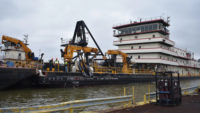Extraordinarily low water levels in the middle reaches of the Mississippi River have complicated barge service and forced companies that supply, deliver and use aggregate and other barge-delivered construction materials to scramble and get creative, sources at those companies said last week.
Still, they said that, in nearly all cases, construction contractors have been able to secure required materials when they are needed and that the U.S. Army Corps of Engineers is doing all it can to maintain acceptable water levels and minimize barge-flow disruptions.
A severe drought has left water levels near historic lows on parts of the Mississippi, especially the 200-mile “choke point” between St. Louis, where the Missouri River flows in, and Cairo, Ill., at the Ohio River confluence, said Mike Petersen, spokesman for the Corps’ St. Louis District.
Since the last major drought in 1988-89, the Corps has been removing underwater rocks that threaten barges and other vessels during low-water periods; also, it has been installing “river training structures,” such as dikes, chevrons and "bendway" weirs, to maintain reliable, navigable channels, Petersen said.
He said the current drought “was on our radar very early”—months before the drought peaked this past summer—enabling the Corps to carefully manage upstream stockpiles of water for gradual, as-needed release this past fall and early winter.
“There’s normally a 12-foot draft” in the middle Mississippi, but the Corps lowered that to nine feet last summer, forcing big cuts in the amount of material each barge could carry, said Ann McCullouch, spokeswoman for American Waterways Operators, the trade association for the U.S. tugboat, towboat and barge industry.
Around Thanksgiving, the Corps trimmed flows from the Missouri River. McCullouch said, “We sounded alarm bells” that further reductions in draft levels in the middle Mississippi could bring barge traffic there to a halt, harming both the regional and national economy.
The Corps then undertook emergency rock-removal work in a six-mile stretch of the Mississippi near Thebes, Ill., a few miles upstream from Cairo. That work was expected to be finished in mid-January, said the Corps’ Peterson. The Corps now is confident it can maintain a nine-foot draft through the end of January, he adds.
“That’s when nature meets us halfway,” said Petersen, explaining that water flows down the upper Mississippi and the Missouri typically rise through late January and February, increasing water levels in the critically important stretch between St. Louis and Cairo.
“We really were looking at a potential shutdown” of barge traffic on the middle Mississippi, if the Corps had not expedited the Thebes-area rock-removal work, said Debra Colbert, senior vice president at the Waterways Council, a group whose members either barge bulk materials or supply or buy bulk materials delivered by water.






Post a comment to this article
Report Abusive Comment